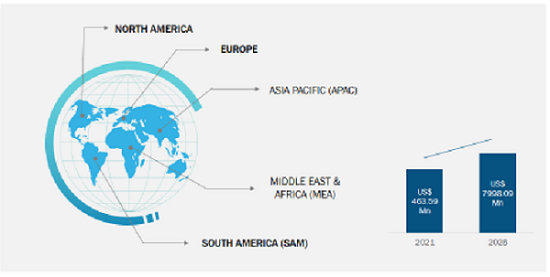Chronic Care Management and Virtual Care Options Drive Growth of Connected Drug Delivery Devices Market
According to the latest study on "Connected Drug Delivery Devices Market Forecast to 2028 – COVID-19 Impact and Global Analysis – by Type, Technology, End User, and Geography," the connected drug delivery devices market is expected to grow from US$ 463.59 million in 2021 to US$ 7,998.09 million by 2028; it is estimated to grow at a CAGR of 50.3% from 2022 to 2028.

Connected Drug Delivery Devices Market Size, Share, and Growth by 2031
Download Free SampleConnected Drug Delivery Devices Market Size and Forecasts (2021 - 2031), Global and Regional Share, Trends, and Growth Opportunity Analysis Report Coverage: by Type [Connected Sensors (Connected Inhaler Sensors and Connected Injection Sensors), Integrated Devices (Connected Inhaler Devices and Connected Injection Devices), and Platform & Service, Technology [Bluetooth, Near Field Communication (NFC), Cellular Networks, and Others], and End User (Hospitals, Homecare, and Others), and Geography (North America, Europe, Asia Pacific, and South and Central America)
The rising incidence of diabetes, asthma, hypertension, tuberculosis, multiple sclerosis, clinically isolated syndrome, and other chronic diseases is expected to propel the connected drug delivery devices market from 2022 to 2028. According to the National Diabetes Statistics Report, 37.9 million people (~ 11% of the global population) of all ages had diabetes in the US in 2020. Connected drug delivery devices/systems have been found to be potentially beneficial for effective diabetes treatment, such as improving the stability/dosage of drugs, overcoming different biological barriers in vivo to increase bioavailability, and acting as an automatized system to mimic endogenous insulin delivery and reduce the risk of hypoglycemia among population. Also, owing to the COVID-19 crisis, the adoption of virtual treatment has increased. The connected drug delivery devices send notifications regarding patient’s health status to the healthcare professionals and keep a medication track. Such a factor is expected to bolster the growth of the connected drug delivery devices market during the forecast period. Based on type, the market is segmented into connected sensors, integrated devices, and platform & services. The market for the connected sensors segment is further bifurcated into connected inhaler sensors and connected injection sensors. The market for the integrated devices segment is subsegmented into connected inhaler devices and connected injection devices. The connected sensors segment captured the largest share in 2021. The segment captured more than 70% of the market in 2021 and is anticipated to retain its dominance during the forecast period. Connected sensors can be easily connected to existing devices and can be reused too. The inhalation devices such as needless drug delivery techniques, have increased the demand of inhalation devices all the more. On the other hand, the platform & services segment is expected to register the highest CAGR during the forecast period.
Based on technology, the connected delivery drug devices market is segmented into Bluetooth, cellular networks, near field communication (NFC), and others. The Bluetooth segment accounted for the largest market share in 2021 and is expected to dominate the market over the forecast period. The Bluetooth technology is cheapest than near field communication (NFC) and cellular network.
Based on end user, the connected drug delivery devices market is segmented into hospitals, homecare, and others. The hospitals segment accounted for the largest market share in 2021 and is expected to continue its dominance in the market over the forecast period. On the other hand, the homecare segment is expected to register the highest CAGR during the forecast period. The easy of medication administration in homecare settings without the help of healthcare professionals is expected to drive the market growth for the segment in the future. Spirale drug delivery system manufactured by Armstrong Medical is an alternative treatment to nebulization for bronchodilator therapy. The device optimizes alveolar drug deposition using a carefully designed jet orifice in combination with volumizing geometry. This collapsible volumizing chamber is designed to deliver micro-drug particles from a Metered Dose Inhaler (MDI). The product is intended to remain in the breathing circuit, therefore removing the risk of environmental contamination in the healthcare settings, including hospitals, clinics, long-term care centers, urgent care centers, and ambulatory surgical centers. The device can be positioned in the inspiratory limb of the breathing circuit or is equally suitable in a catheter mount or connected directly to the patient connector. Spirale is intended to remain in the breathing system and does not require disconnection from the breathing system for each treatment, reducing the risk of ventilator acquired pneumonia (VAP).
Propeller Health, Adherium Limited, West Pharmaceutical Services, FindAir, Phillips-Medisize, Biocorp, 3M, Cohero Health, and Merck Group are a few key players profiled during the study of the connected drug delivery devices market. Several other major companies were analyzed during this study to get a holistic view of the market and its ecosystem.
Contact Us
Phone: +1-646-491-9876
Email Id: sales@theinsightpartners.com